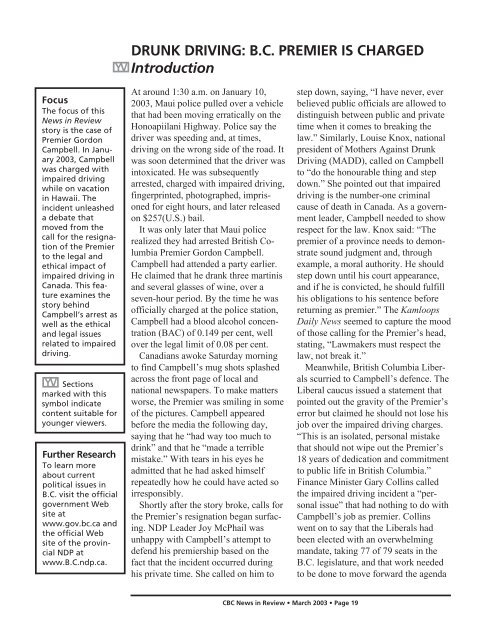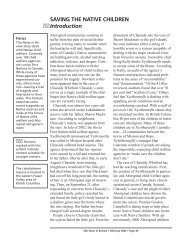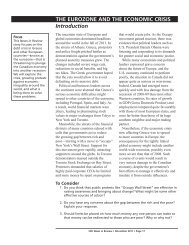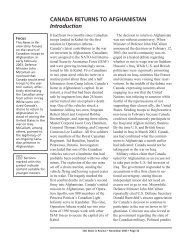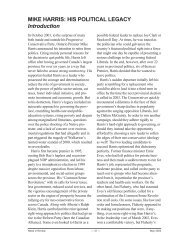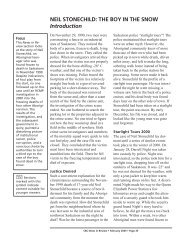DRUNK DRIVING: B.C. PREMIER IS CHARGED ... - News in review
DRUNK DRIVING: B.C. PREMIER IS CHARGED ... - News in review
DRUNK DRIVING: B.C. PREMIER IS CHARGED ... - News in review
Create successful ePaper yourself
Turn your PDF publications into a flip-book with our unique Google optimized e-Paper software.
Focus<br />
The focus of this<br />
<strong>News</strong> <strong>in</strong> Review<br />
story is the case of<br />
Premier Gordon<br />
Campbell. In January<br />
2003, Campbell<br />
was charged with<br />
impaired driv<strong>in</strong>g<br />
while on vacation<br />
<strong>in</strong> Hawaii. The<br />
<strong>in</strong>cident unleashed<br />
a debate that<br />
moved from the<br />
call for the resignation<br />
of the Premier<br />
to the legal and<br />
ethical impact of<br />
impaired driv<strong>in</strong>g <strong>in</strong><br />
Canada. This feature<br />
exam<strong>in</strong>es the<br />
story beh<strong>in</strong>d<br />
Campbell’s arrest as<br />
well as the ethical<br />
and legal issues<br />
related to impaired<br />
driv<strong>in</strong>g.<br />
YV<br />
Sections<br />
marked with this<br />
symbol <strong>in</strong>dicate<br />
content suitable for<br />
younger viewers.<br />
Further Research<br />
To learn more<br />
about current<br />
political issues <strong>in</strong><br />
B.C. visit the official<br />
government Web<br />
site at<br />
www.gov.bc.ca and<br />
the official Web<br />
site of the prov<strong>in</strong>cial<br />
NDP at<br />
www.B.C.ndp.ca.<br />
YV<br />
<strong>DRUNK</strong> <strong>DRIVING</strong>: B.C. <strong>PREMIER</strong> <strong>IS</strong> <strong>CHARGED</strong><br />
Introduction<br />
At around 1:30 a.m. on January 10,<br />
2003, Maui police pulled over a vehicle<br />
that had been mov<strong>in</strong>g erratically on the<br />
Honoapiilani Highway. Police say the<br />
driver was speed<strong>in</strong>g and, at times,<br />
driv<strong>in</strong>g on the wrong side of the road. It<br />
was soon determ<strong>in</strong>ed that the driver was<br />
<strong>in</strong>toxicated. He was subsequently<br />
arrested, charged with impaired driv<strong>in</strong>g,<br />
f<strong>in</strong>gerpr<strong>in</strong>ted, photographed, imprisoned<br />
for eight hours, and later released<br />
on $257(U.S.) bail.<br />
It was only later that Maui police<br />
realized they had arrested British Columbia<br />
Premier Gordon Campbell.<br />
Campbell had attended a party earlier.<br />
He claimed that he drank three mart<strong>in</strong>is<br />
and several glasses of w<strong>in</strong>e, over a<br />
seven-hour period. By the time he was<br />
officially charged at the police station,<br />
Campbell had a blood alcohol concentration<br />
(BAC) of 0.149 per cent, well<br />
over the legal limit of 0.08 per cent.<br />
Canadians awoke Saturday morn<strong>in</strong>g<br />
to f<strong>in</strong>d Campbell’s mug shots splashed<br />
across the front page of local and<br />
national newspapers. To make matters<br />
worse, the Premier was smil<strong>in</strong>g <strong>in</strong> some<br />
of the pictures. Campbell appeared<br />
before the media the follow<strong>in</strong>g day,<br />
say<strong>in</strong>g that he “had way too much to<br />
dr<strong>in</strong>k” and that he “made a terrible<br />
mistake.” With tears <strong>in</strong> his eyes he<br />
admitted that he had asked himself<br />
repeatedly how he could have acted so<br />
irresponsibly.<br />
Shortly after the story broke, calls for<br />
the Premier’s resignation began surfac<strong>in</strong>g.<br />
NDP Leader Joy McPhail was<br />
unhappy with Campbell’s attempt to<br />
defend his premiership based on the<br />
fact that the <strong>in</strong>cident occurred dur<strong>in</strong>g<br />
his private time. She called on him to<br />
CBC <strong>News</strong> <strong>in</strong> Review • March 2003 • Page 19<br />
step down, say<strong>in</strong>g, “I have never, ever<br />
believed public officials are allowed to<br />
dist<strong>in</strong>guish between public and private<br />
time when it comes to break<strong>in</strong>g the<br />
law.” Similarly, Louise Knox, national<br />
president of Mothers Aga<strong>in</strong>st Drunk<br />
Driv<strong>in</strong>g (MADD), called on Campbell<br />
to “do the honourable th<strong>in</strong>g and step<br />
down.” She po<strong>in</strong>ted out that impaired<br />
driv<strong>in</strong>g is the number-one crim<strong>in</strong>al<br />
cause of death <strong>in</strong> Canada. As a government<br />
leader, Campbell needed to show<br />
respect for the law. Knox said: “The<br />
premier of a prov<strong>in</strong>ce needs to demonstrate<br />
sound judgment and, through<br />
example, a moral authority. He should<br />
step down until his court appearance,<br />
and if he is convicted, he should fulfill<br />
his obligations to his sentence before<br />
return<strong>in</strong>g as premier.” The Kamloops<br />
Daily <strong>News</strong> seemed to capture the mood<br />
of those call<strong>in</strong>g for the Premier’s head,<br />
stat<strong>in</strong>g, “Lawmakers must respect the<br />
law, not break it.”<br />
Meanwhile, British Columbia Liberals<br />
scurried to Campbell’s defence. The<br />
Liberal caucus issued a statement that<br />
po<strong>in</strong>ted out the gravity of the Premier’s<br />
error but claimed he should not lose his<br />
job over the impaired driv<strong>in</strong>g charges.<br />
“This is an isolated, personal mistake<br />
that should not wipe out the Premier’s<br />
18 years of dedication and commitment<br />
to public life <strong>in</strong> British Columbia.”<br />
F<strong>in</strong>ance M<strong>in</strong>ister Gary Coll<strong>in</strong>s called<br />
the impaired driv<strong>in</strong>g <strong>in</strong>cident a “personal<br />
issue” that had noth<strong>in</strong>g to do with<br />
Campbell’s job as premier. Coll<strong>in</strong>s<br />
went on to say that the Liberals had<br />
been elected with an overwhelm<strong>in</strong>g<br />
mandate, tak<strong>in</strong>g 77 of 79 seats <strong>in</strong> the<br />
B.C. legislature, and that work needed<br />
to be done to move forward the agenda
The Measure of<br />
Impaired Driv<strong>in</strong>g<br />
Blood alcohol<br />
concentration<br />
(BAC) refers to the<br />
percentage of<br />
alcohol <strong>in</strong> the<br />
blood. In Canada,<br />
the legal limit<br />
established <strong>in</strong> the<br />
Crim<strong>in</strong>al Code for<br />
dr<strong>in</strong>k<strong>in</strong>g and<br />
driv<strong>in</strong>g is 80 milligrams<br />
of alcohol <strong>in</strong><br />
100 millilitres of<br />
blood, or 0.08 per<br />
cent. However,<br />
most prov<strong>in</strong>cial and<br />
territorial jurisdictions<br />
have adm<strong>in</strong>istrative<br />
driver’s<br />
license suspensions<br />
<strong>in</strong> their traffic code<br />
at 0.05 per cent or<br />
lower. Therefore,<br />
someone could<br />
have their license<br />
suspended under<br />
the prov<strong>in</strong>cial<br />
traffic code for<br />
hav<strong>in</strong>g a BAC of<br />
0.05 per cent, but<br />
the matter becomes<br />
a federal<br />
crim<strong>in</strong>al offence<br />
when the BAC<br />
reaches 0.08 per<br />
cent.<br />
Def<strong>in</strong>ition<br />
A pundit is a person<br />
who has a<br />
certa<strong>in</strong> expertise.<br />
Interest<strong>in</strong>gly, this<br />
popular political<br />
term orig<strong>in</strong>ated <strong>in</strong><br />
India and described<br />
a H<strong>in</strong>du educated<br />
<strong>in</strong> Sanskrit, law,<br />
and philosophy.<br />
on which they were elected. He said<br />
that Campbell played a key role <strong>in</strong> the<br />
emergence of the Liberal platform and<br />
the election victory. He needed to stay<br />
<strong>in</strong> his position to fulfill his mandate.<br />
Political pundits have had a field day<br />
with the case of Premier Campbell. The<br />
debate over whether or not the Premier<br />
should resign has been at the centre of<br />
most of the discussions. However, some<br />
perspectives have proven more eloquent<br />
than others, focus<strong>in</strong>g on what many see<br />
as the real issue: impaired driv<strong>in</strong>g. Ian<br />
Mulgrew of the Vancouver Sun po<strong>in</strong>ts<br />
out that defenders of Campbell have<br />
been careful to avoid call<strong>in</strong>g impaired<br />
driv<strong>in</strong>g a crime. Instead people are<br />
referr<strong>in</strong>g to the <strong>in</strong>cident as “a misdemeanor,”<br />
“a terrible mistake,” “an<br />
irresponsible and shameful th<strong>in</strong>g,” or “a<br />
misjudgment.” With over 70 000<br />
charges laid every year <strong>in</strong> Canada,<br />
Mulgrew reiterates MADD’s perspective:<br />
drunk driv<strong>in</strong>g is a serious crime.<br />
Mulgrew concludes that, “It’s hard to<br />
CBC <strong>News</strong> <strong>in</strong> Review • March 2003 • Page 20<br />
be simultaneously the top lawmaker and<br />
B.C.’s best-known crim<strong>in</strong>al.” Meanwhile,<br />
The Ottawa Citizen’s Charles<br />
Gordon says that the <strong>in</strong>cident provides<br />
an opportunity for Premier Campbell to<br />
create a legacy. By stay<strong>in</strong>g <strong>in</strong> office, he<br />
could use his mistake to put forward an<br />
agenda that sets a higher standard for<br />
impaired driv<strong>in</strong>g. He could work with<br />
victim advocacy organizations to improve<br />
exist<strong>in</strong>g laws or make changes<br />
that allow law enforcement agencies to<br />
deal with the problem of impaired<br />
driv<strong>in</strong>g more effectively. If Campbell<br />
wants to make th<strong>in</strong>gs right, Charles<br />
Gordon th<strong>in</strong>ks he needs to demonstrate<br />
his commitment to reduc<strong>in</strong>g impaired<br />
driv<strong>in</strong>g <strong>in</strong> his own country.<br />
In the meantime, Campbell has<br />
decided to plead guilty to the impaired<br />
driv<strong>in</strong>g charges and stay on as premier.<br />
He has vowed never to dr<strong>in</strong>k alcohol<br />
aga<strong>in</strong>. Many critics wonder if this is<br />
enough.<br />
Questions<br />
What disturb<strong>in</strong>g photographs did Canadians see <strong>in</strong> local and national newspapers<br />
the day after Premier Campbell was charged with impaired driv<strong>in</strong>g?<br />
Why do you th<strong>in</strong>k people were disturbed by these pictures? Expla<strong>in</strong>.
This read<strong>in</strong>g offers a range of op<strong>in</strong>ions on the issue of whether Gordon<br />
Campbell should resign. Use the follow<strong>in</strong>g table to outl<strong>in</strong>e the arguments<br />
for and aga<strong>in</strong>st the Premier’s resignation and then write up your f<strong>in</strong>al view<br />
on this controversial issue.<br />
Why Campbell Should Resign Why Campbell Should Not Resign<br />
My F<strong>in</strong>al Decision<br />
Is the Premier’s vow to never dr<strong>in</strong>k aga<strong>in</strong> enough? Expla<strong>in</strong> your answer.<br />
What advice would you give to Gordon Campbell?<br />
CBC <strong>News</strong> <strong>in</strong> Review • March 2003 • Page 21
Answer the questions<br />
on this and<br />
the follow<strong>in</strong>g<br />
pages while <strong>review</strong><strong>in</strong>g<br />
the video story.<br />
It may be necessary<br />
to answer the more<br />
complex questions<br />
after you have seen<br />
the video.<br />
YV<br />
<strong>DRUNK</strong> <strong>DRIVING</strong>: B.C. <strong>PREMIER</strong> <strong>IS</strong> <strong>CHARGED</strong><br />
Video Review<br />
1. How have people’s attitudes changed about dr<strong>in</strong>k<strong>in</strong>g and driv<strong>in</strong>g?<br />
2. What happened while B.C. Premier Gordon Campbell was on vacation<br />
<strong>in</strong> Hawaii <strong>in</strong> January 2003?<br />
3. What is former NDP strategist Bill Tieleman’s position regard<strong>in</strong>g the<br />
Campbell situation?<br />
4. How did Campbell feel about the <strong>in</strong>cident <strong>in</strong> Maui? Was he sorry for<br />
what he did? Did he show remorse when he appeared before the<br />
media?<br />
5. Does the Premier plan to fight the charges aga<strong>in</strong>st him?<br />
CBC <strong>News</strong> <strong>in</strong> Review • March 2003 • Page 22
6. What was the result of Campbell’s roadside breath test?<br />
7. Name two other high-profile political figures who have been <strong>in</strong>volved<br />
<strong>in</strong> impaired driv<strong>in</strong>g <strong>in</strong>cidents.<br />
8. From where do most statistics regard<strong>in</strong>g impaired driv<strong>in</strong>g crashes<br />
come? What problems arise from this method of data collection?<br />
9. What percentage of fatally <strong>in</strong>jured drivers were impaired at the time<br />
of their crashes?<br />
10. What are the three character profiles of drunk drivers?<br />
CBC <strong>News</strong> <strong>in</strong> Review • March 2003 • Page 23
Did you know . . .<br />
Premier Campbell’s<br />
roadside breath<br />
test was 0.161 per<br />
cent? When he was<br />
tested aga<strong>in</strong> at the<br />
police station his<br />
BAC result was<br />
0.149 per cent.<br />
11. How are some prov<strong>in</strong>ces toughen<strong>in</strong>g penalties for impaired drivers?<br />
12. What techniques were used to demonstrate the feel<strong>in</strong>g of be<strong>in</strong>g impaired<br />
at the lunchtime demonstration <strong>in</strong> Fredericton?<br />
13. What motivated Mark Savard to use hypnosis to teach people about<br />
the effects of dr<strong>in</strong>k<strong>in</strong>g and driv<strong>in</strong>g?<br />
14. Outl<strong>in</strong>e your personal views on dr<strong>in</strong>k<strong>in</strong>g and driv<strong>in</strong>g.<br />
15. Describe any <strong>in</strong>cidents of dr<strong>in</strong>k<strong>in</strong>g and driv<strong>in</strong>g <strong>in</strong> your own community.<br />
CBC <strong>News</strong> <strong>in</strong> Review • March 2003 • Page 24
The Master said,<br />
“He who rules by<br />
moral force is like<br />
the pole-star, which<br />
rema<strong>in</strong>s <strong>in</strong> its place<br />
while all the lesser<br />
stars do homage<br />
to it.” — The<br />
Analects of Confucius,<br />
Book 2, 1<br />
Further Research<br />
Information about<br />
the life and teach<strong>in</strong>gs<br />
of Confucius<br />
may be found at<br />
www.cifnet.com/<br />
~geenius/kongfuzi/.<br />
Reciprocity — treat<br />
others as you<br />
would want to be<br />
treated<br />
Propriety — us<strong>in</strong>g<br />
wisdom to guide<br />
your actions<br />
<strong>DRUNK</strong> <strong>DRIVING</strong>: B.C. <strong>PREMIER</strong> <strong>IS</strong> <strong>CHARGED</strong><br />
Government, Ethics, and Confucius<br />
The case of Gordon Campbell poses a<br />
number of ethical questions, some of<br />
which concern the way we are governed.<br />
Perhaps it would be useful to go<br />
back <strong>in</strong>to the archives to see if<br />
Campbell’s actions meet the standards<br />
established by an ancient philosopher.<br />
The Ch<strong>in</strong>ese sage Confucius (551-479<br />
BCE) felt that a leader and his or her<br />
government should set an example<br />
based on virtue. True virtue is expressed<br />
through reciprocity and propriety.<br />
Reciprocity is captured <strong>in</strong> the<br />
Confucian golden rule that says, “Do<br />
not do unto others what you would not<br />
have done unto you” (Analects 15, 23).<br />
In other words, relationships should be<br />
reciprocal, with the best <strong>in</strong>terests of<br />
everyone taken <strong>in</strong>to consideration before<br />
an action is taken. Propriety is the art of<br />
right conduct. It calls on the <strong>in</strong>dividual to<br />
express their <strong>in</strong>ner wisdom <strong>in</strong> their outer<br />
expression. A great leader th<strong>in</strong>ks before<br />
she acts, us<strong>in</strong>g her collected wisdom to<br />
guide her choices. In the end, true<br />
leadership <strong>in</strong> government is the embodiment<br />
of both reciprocity and propriety.<br />
For the purposes of our study we have to<br />
ask: Does the case of Premier Campbell<br />
pass the test of reciprocity and propriety?<br />
Before we answer that question, one<br />
more po<strong>in</strong>t needs to be made regard<strong>in</strong>g<br />
virtuous leadership. Accord<strong>in</strong>g to<br />
Confucius, true leaders cultivate virtue<br />
<strong>in</strong> their lives. Only when the leader has<br />
achieved a sense of virtue can she<br />
govern effectively. The result of virtuous<br />
leadership is a virtuous citizenry<br />
and, <strong>in</strong> turn, a well-ordered state. In<br />
other words, people honour and respect<br />
governments because they can see the<br />
s<strong>in</strong>cerity and virtue of their leaders.<br />
When that virtue is absent, people become<br />
jaded and suspicious of government.<br />
CBC <strong>News</strong> <strong>in</strong> Review • March 2003 • Page 25<br />
Test #1: Reciprocity<br />
There is no question that Campbell’s<br />
choice to dr<strong>in</strong>k and drive fails the test<br />
of reciprocity. People who choose to<br />
drive while impaired are not exercis<strong>in</strong>g<br />
proper concern for themselves or others.<br />
Based on the pr<strong>in</strong>cipal of reciprocity,<br />
Campbell should accept whatever<br />
penalty the state of Hawaii imposes.<br />
S<strong>in</strong>ce Campbell seems will<strong>in</strong>g to accept<br />
this consequence, he is act<strong>in</strong>g properly<br />
<strong>in</strong> this regard.<br />
However, should the Premier have<br />
resigned over his conduct? The debate<br />
over whether or not the he should have<br />
resigned sw<strong>in</strong>gs between two poles. On<br />
the one hand, people th<strong>in</strong>k that he<br />
should have resigned because he made<br />
such a poor choice. Others feel he made<br />
a serious mistake on his private time<br />
and he should be allowed to cont<strong>in</strong>ue to<br />
lead British Columbia.<br />
Task #1:<br />
Now it’s your turn. Work with a<br />
partner and try to figure out<br />
whether or not Campbell should<br />
have resigned as premier. Support<br />
your conclusions with specific reference<br />
to Confucius’ idea of reciprocity<br />
and his view of political leadership.<br />
Record your conclusions <strong>in</strong> your<br />
notebook.<br />
Test #2: Propriety<br />
There is no defend<strong>in</strong>g Campbell’s<br />
conduct on the night he was charged<br />
with impaired driv<strong>in</strong>g. Clearly he failed<br />
to act with propriety <strong>in</strong> this <strong>in</strong>stance.<br />
However, once aga<strong>in</strong>, we must ask the<br />
question: should he have quit as premier?<br />
The two schools of thought weigh <strong>in</strong><br />
aga<strong>in</strong> on this issue. On the one hand,<br />
some feel that the Premier’s conduct
was so reprehensible he cannot be<br />
forgiven. He has lost the public’s trust<br />
and should resign. On the other hand,<br />
some people feel that the Premier’s<br />
contribution to public life <strong>in</strong> British<br />
Columbia should not be wiped out by<br />
one terrible mistake.<br />
Task #2:<br />
It’s your turn aga<strong>in</strong>. Work with a<br />
partner and discuss whether Premier<br />
Campbell should have resigned.<br />
Remember to refer to Confucius’<br />
views on propriety and political<br />
leadership. Aga<strong>in</strong>, record your conclusions<br />
<strong>in</strong> your notebook.<br />
Test #3: What is Campbell’s<br />
standard for ethical political<br />
conduct?<br />
Gordon Campbell has witnessed quite a<br />
few scandals s<strong>in</strong>ce becom<strong>in</strong>g an MLA<br />
<strong>in</strong> the B.C. legislature, and he was the<br />
leader of the opposition who spearheaded<br />
the call for several high-profile<br />
resignations. To put it simply, the B.C.<br />
premiership has been a testament to<br />
controversial political leadership. Take<br />
a look at the follow<strong>in</strong>g examples:<br />
• 1991: Premier Bill Vander Zalm of<br />
the Social Credit Party resigns after<br />
allegations that he used the premier’s<br />
office to sell a religious theme park to<br />
an overseas billionaire. The prov<strong>in</strong>ce’s<br />
conflict commissioner eventually<br />
determ<strong>in</strong>ed that Vander Zalm had<br />
acted <strong>in</strong>appropriately.<br />
• 1995: Premier Mike Harcourt of the<br />
New Democratic Party resigns after<br />
his party is implicated <strong>in</strong> a charity<br />
b<strong>in</strong>go money-skimm<strong>in</strong>g scandal.<br />
CBC <strong>News</strong> <strong>in</strong> Review • March 2003 • Page 26<br />
• 1999: Premier Glen Clark of the NDP<br />
resigns after allegedly aid<strong>in</strong>g a<br />
neighbour <strong>in</strong> atta<strong>in</strong><strong>in</strong>g a cas<strong>in</strong>o license<br />
from the prov<strong>in</strong>ce. Clark was acquitted<br />
of charges that he accepted a<br />
benefit of $10 000 <strong>in</strong> home and cottage<br />
renovations from the neighbour.<br />
However, the prov<strong>in</strong>ce’s conflict<br />
commissioner ruled that Clark had<br />
violated two sections of the Conflict<br />
of Interest Act and ordered him to pay<br />
$53 000—half the cost of the<br />
commissioner’s <strong>in</strong>vestigation.<br />
Campbell assumed the premiership<br />
after a stunn<strong>in</strong>g electoral victory <strong>in</strong> May<br />
2001, tak<strong>in</strong>g all but two seats <strong>in</strong> the<br />
legislature. He promised to rid the<br />
premier’s office of corruption and<br />
scandal. He also told the public that<br />
politicians be<strong>in</strong>g <strong>in</strong>vestigated by police<br />
should step down until they have been<br />
cleared of charges.<br />
Task #3:<br />
Work with a partner and answer the<br />
follow<strong>in</strong>g questions:<br />
Confucius said that a virtuous leadership<br />
leads to a virtuous and wellordered<br />
state. Do our leaders provide<br />
virtuous leadership? Is Canada a<br />
well-ordered state? Should politicians<br />
be held to a higher moral<br />
standard than the rest of society?<br />
Based on our work <strong>in</strong> tasks one and<br />
two, should Campbell have resigned?<br />
Give reasons to support your<br />
conclusions.<br />
Be prepared to present your conclusions<br />
to the class.
YV<br />
<strong>DRUNK</strong> <strong>DRIVING</strong>: B.C. <strong>PREMIER</strong> <strong>IS</strong> <strong>CHARGED</strong><br />
Canadian Impaired Driv<strong>in</strong>g Laws<br />
This year, Canadians will take an<br />
estimated 12.5 million impaired-driv<strong>in</strong>g<br />
trips. The police will lay over 70 000<br />
impaired-driv<strong>in</strong>g charges. Drunk drivers<br />
will kill at least one person per day.<br />
These chill<strong>in</strong>g facts are what motivate<br />
organizations like the Canada Safety<br />
Council to encourage federal and<br />
prov<strong>in</strong>cial governments to direct resources<br />
<strong>in</strong>to mak<strong>in</strong>g exist<strong>in</strong>g laws work<br />
better. Effective laws are a key compo-<br />
CBC <strong>News</strong> <strong>in</strong> Review • March 2003 • Page 27<br />
nent <strong>in</strong> the battle aga<strong>in</strong>st impaired<br />
driv<strong>in</strong>g. Recent amendments to the<br />
Crim<strong>in</strong>al Code have made fundamental<br />
changes to how the Canadian legal<br />
system approaches the charg<strong>in</strong>g and<br />
sentenc<strong>in</strong>g of drunk drivers. Complete<br />
the follow<strong>in</strong>g Canada Safety Council<br />
quiz (circle your choices) to test your<br />
understand<strong>in</strong>g of the laws deal<strong>in</strong>g with<br />
impaired driv<strong>in</strong>g <strong>in</strong> Canada. The answers<br />
are on the next page.<br />
1. The f<strong>in</strong>e for a first-time impaired-driv<strong>in</strong>g conviction is:<br />
a. $100<br />
b. $300<br />
c. $600<br />
2. At what m<strong>in</strong>imum blood alcohol concentration (BAC) can a driver be<br />
charged with a crim<strong>in</strong>al offence?<br />
a. 0.05*<br />
b. 0.08<br />
c. 0.15<br />
(*50 milligrams of alcohol <strong>in</strong> 100 millilitres of blood, or 50 mg%)<br />
3. Accord<strong>in</strong>g to recent changes <strong>in</strong> the Crim<strong>in</strong>al Code, the maximum sentence<br />
for impaired driv<strong>in</strong>g caus<strong>in</strong>g death is:<br />
a. eight years<br />
b. 14 years<br />
c. life <strong>in</strong> prison<br />
4. The usual m<strong>in</strong>imum driv<strong>in</strong>g prohibition period for a first impaireddriv<strong>in</strong>g<br />
offence under the Crim<strong>in</strong>al Code of Canada is:<br />
a. 30 days<br />
b three months<br />
c. one year<br />
5. How many offences related to impaired driv<strong>in</strong>g were reported <strong>in</strong><br />
Canada <strong>in</strong> 2000?<br />
a. 9000<br />
b. 80 000<br />
c. 185 000
Canada has one of<br />
the strictest impaired<br />
driv<strong>in</strong>g laws<br />
<strong>in</strong> the world. The<br />
Canada Safety<br />
Council’s position is<br />
that resources are<br />
urgently needed to<br />
make exist<strong>in</strong>g laws<br />
work more effectively<br />
and that new<br />
countermeasures<br />
are needed to<br />
combat the chronic<br />
high-BAC offender.<br />
Do agree or disagree?<br />
Answers (Source: www.safety-council.org/quiz/dwiq)<br />
1. c) At $600, Canada imposes one of the highest m<strong>in</strong>imum f<strong>in</strong>es <strong>in</strong> the world<br />
for blood alcohol offenses.<br />
2. b) In most prov<strong>in</strong>ces and territories it is not permissible to operate a motor<br />
vehicle at BACs over 0.05, but this becomes a crim<strong>in</strong>al matter when levels<br />
exceed 0.08.<br />
3. c) Canada considers impaired driv<strong>in</strong>g as serious an offense as murder. In June<br />
2000 the maximum penalty was raised from 14 years to life <strong>in</strong> prison.<br />
4. c) Canada’s one-year prohibition is one of the longest mandatory driv<strong>in</strong>g<br />
disqualifications <strong>in</strong> the world.<br />
5. b) Accord<strong>in</strong>g to Statistics Canada, there were 79 107 Crim<strong>in</strong>al Code offences<br />
related to impaired operation of any vehicle <strong>in</strong> 2000.<br />
Questions<br />
1. How did you do on the quiz? Why do you th<strong>in</strong>k you did or did not do well?<br />
2. Do you th<strong>in</strong>k Canadian impaired driv<strong>in</strong>g laws are strict enough? Expla<strong>in</strong><br />
your position.<br />
3. Japan has a legal blood alcohol limit of zero. Is this too strict? Expla<strong>in</strong>.<br />
4. Do you th<strong>in</strong>k people should be kept from operat<strong>in</strong>g a motor vehicle<br />
even if they have only had one dr<strong>in</strong>k? Why?<br />
5. In the 1980s, impaired driv<strong>in</strong>g deaths peaked at 2100 per year. Victim<br />
advocacy groups like MADD started to vigorously fight for improved<br />
laws. They created greater awareness of the effects of impaired driv<strong>in</strong>g<br />
on society. The result was a 30 per cent drop <strong>in</strong> impaired driv<strong>in</strong>g deaths<br />
by the 1990s. What else needs to be done? Suggest three practical<br />
ideas that could be <strong>in</strong>troduced to fight impaired driv<strong>in</strong>g <strong>in</strong> Canada.<br />
i) ________________________________________________________________<br />
ii) ________________________________________________________________<br />
iii) _______________________________________________________________<br />
CBC <strong>News</strong> <strong>in</strong> Review • March 2003 • Page 28
Visit MADD’s Web<br />
site at<br />
www.madd.ca and<br />
<strong>in</strong>vestigate the<br />
programs that<br />
MADD <strong>in</strong>itiates to<br />
combat dr<strong>in</strong>k<strong>in</strong>g<br />
and driv<strong>in</strong>g and to<br />
raise public awareness.<br />
F<strong>in</strong>d one<br />
program that<br />
appeals to you and<br />
report your f<strong>in</strong>d<strong>in</strong>gs<br />
to the class.<br />
Consider <strong>in</strong>vit<strong>in</strong>g a<br />
MADD spokesperson<br />
to visit your<br />
class or school.<br />
YV<br />
<strong>DRUNK</strong> <strong>DRIVING</strong>: B.C. <strong>PREMIER</strong> <strong>IS</strong> <strong>CHARGED</strong><br />
Mothers Aga<strong>in</strong>st Drunk Driv<strong>in</strong>g (MADD)<br />
One victims’ advocacy group that<br />
cont<strong>in</strong>ues to grow <strong>in</strong> strength and<br />
conviction is Mothers Aga<strong>in</strong>st Drunk<br />
Driv<strong>in</strong>g (MADD). MADD is a national<br />
organization that is lead<strong>in</strong>g the fight<br />
aga<strong>in</strong>st impaired driv<strong>in</strong>g. Read the<br />
MADD mission statement and statement<br />
of beliefs and then answer the<br />
questions that follow.<br />
MADD Canada Mission<br />
Statement<br />
The Mission of MADD Canada is to<br />
stop impaired driv<strong>in</strong>g and support the<br />
victims of this violent crime.<br />
MADD Canada’s Statements of<br />
Belief<br />
• That our primary reason for existence<br />
is to elim<strong>in</strong>ate the kill<strong>in</strong>g and maim<strong>in</strong>g<br />
caused by impaired driv<strong>in</strong>g.<br />
• Equally vital to MADD Canada’s<br />
existence is support<strong>in</strong>g victims of this<br />
violent crime.<br />
• That MADD Canada is a grassroots<br />
organization that draws its strength,<br />
energy, and leadership from its volunteers.<br />
• That active participation <strong>in</strong> MADD<br />
Canada chapter activities is productive<br />
CBC <strong>News</strong> <strong>in</strong> Review • March 2003 • Page 29<br />
for the community and encourages<br />
heal<strong>in</strong>g for many victims of impaired<br />
driv<strong>in</strong>g.<br />
• An aggressive legislative and public<br />
policy advocacy program is a must to<br />
achieve MADD Canada’s mission.<br />
• That a National Victims’ Bill of<br />
Rights must be created <strong>in</strong> order to<br />
ensure fair and respectful treatment of<br />
all victims of crime.<br />
• That a balanced program of public<br />
awareness, education, legislation, and<br />
aggressive enforcement by police,<br />
crown attorneys, and the courts is<br />
essential to elim<strong>in</strong>at<strong>in</strong>g impaired<br />
driv<strong>in</strong>g.<br />
• That while an <strong>in</strong>dividual’s decision to<br />
consume alcohol is a private matter,<br />
driv<strong>in</strong>g after consum<strong>in</strong>g alcohol is a<br />
public matter.<br />
• That impaired drivers and others who<br />
directly contribute to the crime of<br />
impaired driv<strong>in</strong>g must be held accountable<br />
for their behaviour.<br />
• That proactive rehabilitation of impaired<br />
drivers is essential.<br />
• That driv<strong>in</strong>g is a privilege, not a right.<br />
• That impaired driv<strong>in</strong>g crashes are not<br />
accidents.<br />
Respond<strong>in</strong>g<br />
1. Based on your read<strong>in</strong>g, what is the difference between a mission statement<br />
and a statement of beliefs?
2. Order the top five po<strong>in</strong>ts <strong>in</strong> the statement of beliefs from most important<br />
to least important. Expla<strong>in</strong> the reasons for your choices.<br />
3. What is ‘victims’ advocacy’? Why is this an important objective for MADD?<br />
To Do<br />
Read this MADD Canada fact sheet. Circle the facts you consider most important.<br />
Be prepared to expla<strong>in</strong> your choices.<br />
Fast Facts on MADD Canada<br />
• MADD Canada mission: to stop impaired driv<strong>in</strong>g and to support victims of this<br />
violent crime<br />
• 55 chapters and over 5000 members across the country<br />
• More than 700 000 Canadians donate each year<br />
• Over 4 million red ribbons are distributed annually<br />
• More than 4 million pieces of mail sent each year<br />
• 400 000 high school students see our multimedia assembly presentation<br />
• Approximately one million hits on the Web site per year<br />
• MADD Canada’s annual budget is over $10-million<br />
• Offer programs for victims’ services, public awareness, legal research, chapter<br />
services, and youth services<br />
• FACT <strong>IS</strong> we have a long way to go <strong>in</strong> stopp<strong>in</strong>g impaired driv<strong>in</strong>g<br />
• Four Canadians killed each day and 200 Canadians seriously <strong>in</strong>jured each day<br />
• Approximately 75 000 Canadians impacted by impaired drivers annually<br />
• Estimated 12.5 million trips of impaired driv<strong>in</strong>g each year <strong>in</strong> Canada<br />
• Approximate average of only 70 000 charges of impaired driv<strong>in</strong>g be<strong>in</strong>g laid <strong>in</strong> a<br />
given year<br />
CBC <strong>News</strong> <strong>in</strong> Review • March 2003 • Page 30
<strong>DRUNK</strong> <strong>DRIVING</strong>: B.C. <strong>PREMIER</strong> <strong>IS</strong> <strong>CHARGED</strong><br />
Are Impaired Driv<strong>in</strong>g Statistics Accurate?<br />
There seems to be some discrepancy<br />
regard<strong>in</strong>g impaired driv<strong>in</strong>g statistics.<br />
Read Canada Safety Council President<br />
Emile Therien’s National Post letter to<br />
the editor and answer the questions<br />
below.<br />
Dear Editor:<br />
With much <strong>in</strong>terest, we read the<br />
article “Drunk drivers get a bum rap:<br />
professor,” (National Post, September<br />
30, 2002). The article raises the<br />
issue of accurate, reliable data collection<br />
related to impaired driv<strong>in</strong>g.<br />
Impaired driv<strong>in</strong>g has been called<br />
the lead<strong>in</strong>g crim<strong>in</strong>al cause of death<br />
and <strong>in</strong>jury <strong>in</strong> this country. Given the<br />
high profile of the issue, one would<br />
expect the number of Canadian<br />
victims to be readily accessible. Not so.<br />
In try<strong>in</strong>g to answer this question,<br />
the Canada Safety Council found that<br />
highly respected sources have published<br />
widely diverg<strong>in</strong>g statistics <strong>in</strong><br />
the first half of 2002. Claims range<br />
from 1700 Canadians killed by drunk<br />
drivers every year or 4.5 per day<br />
(MADD Canada), to 1350 deaths each<br />
year <strong>in</strong> alcohol-related motor vehicle<br />
crashes (Transport Canada and the<br />
Canadian Journal of Public Health),<br />
to 906 people killed <strong>in</strong> 1999 <strong>in</strong> road<br />
crashes that <strong>in</strong>volved a driver who<br />
had been dr<strong>in</strong>k<strong>in</strong>g (Traffic Injury<br />
Research Foundation). Our own<br />
January newsletter mistakenly stated<br />
that 1134 people were killed <strong>in</strong> 1999<br />
<strong>in</strong> road crashes <strong>in</strong>volv<strong>in</strong>g an impaired<br />
driver. We thought that was the<br />
correct, up-to-date number. Then we<br />
noticed the other statistics be<strong>in</strong>g<br />
used.<br />
The Traffic Injury Research Foundation<br />
(TIRF) is the source on whose<br />
data the Canada Safety Council<br />
relies. TIRF reported 1134 fatalities <strong>in</strong><br />
CBC <strong>News</strong> <strong>in</strong> Review • March 2003 • Page 31<br />
“alcohol-related crashes” <strong>in</strong> 1999.<br />
However, some “alcohol-related”<br />
traffic deaths do not <strong>in</strong>volve a dr<strong>in</strong>k<strong>in</strong>g<br />
driver—for <strong>in</strong>stance, that statistic<br />
<strong>in</strong>cludes people with alcohol <strong>in</strong> their<br />
blood who were killed by non-dr<strong>in</strong>k<strong>in</strong>g<br />
drivers. (In 1999, a total of 414<br />
pedestrians and 69 cyclists were<br />
killed <strong>in</strong> motor vehicle collisions. Two<br />
out of every five pedestrian fatalities<br />
and one out of five cyclist fatalities<br />
had alcohol <strong>in</strong> their blood.)<br />
The Canada Safety Council is concerned<br />
that us<strong>in</strong>g wrong numbers<br />
can distort an issue and mislead the<br />
public. Misconceptions can lead to<br />
demands for legislative changes that<br />
are not justified when the most<br />
accurate data are exam<strong>in</strong>ed. The<br />
consequences could result <strong>in</strong> flawed<br />
public policy and failed attempts to<br />
curb this very serious problem.<br />
One reason for the discrepancies is<br />
that fatalities have been dropp<strong>in</strong>g.<br />
Impaired drivers are kill<strong>in</strong>g fewer<br />
people each year <strong>in</strong> Canada. In the<br />
U.S., the number of impaired driv<strong>in</strong>g<br />
fatalities has not changed s<strong>in</strong>ce 1994.<br />
In contrast, Canada has made significant<br />
progress. Changes <strong>in</strong> attitudes<br />
and behavior— backed by tough<br />
laws, enforcement and other countermeasures—have<br />
yielded impressive<br />
results.<br />
Accord<strong>in</strong>g to TIRF, road crashes<br />
<strong>in</strong>volv<strong>in</strong>g a driver who had been<br />
dr<strong>in</strong>k<strong>in</strong>g killed 906 people <strong>in</strong> 1999.<br />
This marks a 30% drop over five<br />
years; the equivalent statistic for<br />
1995 was 1296. Prelim<strong>in</strong>ary figures<br />
for 2000, to be released officially this<br />
fall, <strong>in</strong>dicate a further 5% drop.*<br />
Back to the orig<strong>in</strong>al question . . .<br />
should we <strong>in</strong>clude drivers who may<br />
have died as a result of their own<br />
impairment? (Of the 906 fatalities,<br />
dr<strong>in</strong>k<strong>in</strong>g drivers comprised about
Further Research<br />
For more on the<br />
Canada Safety<br />
Council, go to:<br />
www.safetycouncil.org.<br />
half.) What exactly is meant when we<br />
refer to a “drunk” driver? (No simple<br />
def<strong>in</strong>ition exists as a scientific basis<br />
to collect data.) The correct statistic<br />
depends on what <strong>in</strong>formation is<br />
be<strong>in</strong>g conveyed.<br />
Due to the complexities of the<br />
issue there is no official number of<br />
“people killed by drunk drivers” <strong>in</strong><br />
Canada.<br />
The lack of an exact number does<br />
not change the fact that alcoholrelated<br />
crashes still cause far too<br />
many unnecessary and preventable<br />
tragedies on our roads. The fact we<br />
are mak<strong>in</strong>g progress is encourag<strong>in</strong>g,<br />
but we can’t let our guard down.<br />
Hard work and resources will be<br />
CBC <strong>News</strong> <strong>in</strong> Review • March 2003 • Page 32<br />
needed to reach our national goal of<br />
a further 40% reduction <strong>in</strong> road users<br />
fatally or seriously <strong>in</strong>jured <strong>in</strong> crashes<br />
<strong>in</strong>volv<strong>in</strong>g a dr<strong>in</strong>k<strong>in</strong>g driver by 2010.<br />
Canada’s progress to date is an<br />
<strong>in</strong>dication that such an ambitious<br />
goal can be achieved.<br />
S<strong>in</strong>cerely,<br />
Emile Therien<br />
President, Canada Safety Council<br />
* Transport Canada: In 2000, road<br />
crashes <strong>in</strong>volv<strong>in</strong>g a driver who had<br />
been dr<strong>in</strong>k<strong>in</strong>g killed 864 people. Of<br />
those fatalities, almost half (422)<br />
were drivers whose blood alcohol<br />
level was over 0.08.<br />
Questions<br />
1. Make a list of the statistics referred to <strong>in</strong> the third and fourth paragraph<br />
of Therien’s letter.<br />
2. What problem does the Canada Safety Council see regard<strong>in</strong>g impaired<br />
driv<strong>in</strong>g statistics?<br />
3. How could us<strong>in</strong>g the wrong numbers mislead the public and lead to<br />
flawed public policy?<br />
4. How is Canada do<strong>in</strong>g <strong>in</strong> the battle aga<strong>in</strong>st drunk driv<strong>in</strong>g?
YV<br />
<strong>DRUNK</strong> <strong>DRIVING</strong>: B.C. <strong>PREMIER</strong> <strong>IS</strong> <strong>CHARGED</strong><br />
Teens and Drunk Driv<strong>in</strong>g<br />
Car crashes are the lead<strong>in</strong>g cause of<br />
death and <strong>in</strong>jury for young people.<br />
Alcohol is the drug most frequently used<br />
by teenagers. Put the two together and<br />
you have a deadly comb<strong>in</strong>ation.<br />
Based on these facts, governments<br />
have attempted to implement strategies<br />
to make the driv<strong>in</strong>g experience safer for<br />
young people. Several strategies have<br />
proven to be effective. They <strong>in</strong>clude:<br />
• Rais<strong>in</strong>g the dr<strong>in</strong>k<strong>in</strong>g age to 21<br />
CBC <strong>News</strong> <strong>in</strong> Review • March 2003 • Page 33<br />
• Rais<strong>in</strong>g the driv<strong>in</strong>g age<br />
• Graduated licens<strong>in</strong>g<br />
• Zero blood alcohol concentration<br />
(BAC) for young drivers and their<br />
supervisors<br />
• Improved education regard<strong>in</strong>g driv<strong>in</strong>g,<br />
the effects of alcohol and drugs, and<br />
life skills.<br />
Source: www.madd.ca/library/youth/<br />
solution.htm<br />
Your Task<br />
A<br />
Choose one of the strategies listed above or f<strong>in</strong>d another strategy that has<br />
proven to be effective <strong>in</strong> terms of sav<strong>in</strong>g the lives of young drivers. Research<br />
the strategy. Some helpful Web sites <strong>in</strong>clude:<br />
• Mothers Aga<strong>in</strong>st Drunk Driv<strong>in</strong>g: www.madd.ca<br />
• Canada Safety Council: www.safety-council.org/<strong>in</strong>fo/traffic/impaired/<br />
impdriv.htm<br />
• Students Aga<strong>in</strong>st Destructive Decisions: www.saddonl<strong>in</strong>e.com<br />
• Community Learn<strong>in</strong>g Network l<strong>in</strong>k page: www.cln.org/themes/<br />
dr<strong>in</strong>k<strong>in</strong>g_driv<strong>in</strong>g<br />
Make a poster promot<strong>in</strong>g your strategy. Make sure your poster <strong>in</strong>cludes:<br />
• a clear, punchy title (e.g. Don’t Let the Good Die Young! Don’t Dr<strong>in</strong>k<br />
and Drive!)<br />
• artwork or photographs promot<strong>in</strong>g your strategy<br />
• statistical <strong>in</strong>formation support<strong>in</strong>g your strategy<br />
• remember that you are try<strong>in</strong>g to sell your strategy through your poster<br />
so make the poster as attractive and <strong>in</strong>terest<strong>in</strong>g as possible.<br />
B<br />
Write a 250-300 word explanation of your strategy and poster. Be prepared<br />
to present your work to your peers. You might consider us<strong>in</strong>g the posters <strong>in</strong><br />
a campaign to raise awareness of dr<strong>in</strong>k<strong>in</strong>g and driv<strong>in</strong>g <strong>in</strong> your school/community.


